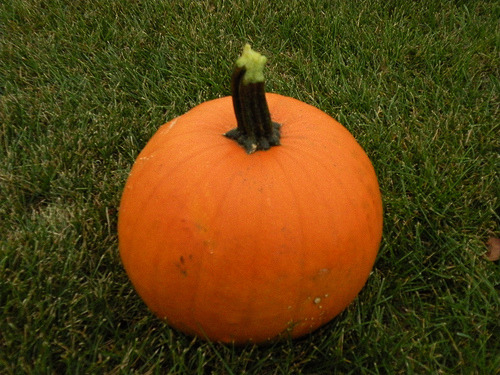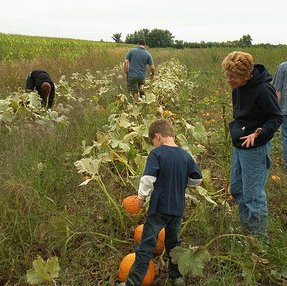This post comes to us courtesy of Melissa Graham, founding Executive Director of Purple Asparagus.
If you ask an ordinary kid about a pumpkin, he or she will probably tell you about jack-o’-lanterns and pie. While these are both fine uses, the students who attend Purple Asparagus’ Delicious Nutritious Adventures program will explain that these two only scratch the surface of the pumpkin’s potential.
These days, I’m travelling from school to school in Chicago teaching our Days of Squash and Pumpkin curriculum. In addition to the pie pumpkin, we introduce elementary school students to Kabocha, Carnival and Sweet Dumpling squash, to name a few.
Our kids know that winter squash is an American original, born in Mexico and introduced to the Old World by Christopher Columbus. They will also explain that the Native Americans included squash in the sanctified trinity of the Three Sisters, along with beans and corn. The beans grew by embracing the corn stalks in lieu of a trellis. The squash lay at the feet of both, protecting its siblings from weed intrusions.
They’ll be sure to share that the tradition of lighting candles inside a carved pumpkin at Halloween is originally from Ireland, where lit vegetables were hung in the window to ward off a wayward soul condemned by the devil to walk the earth for all eternity.
Our students can tell you all this, but most importantly, they will explain that the culinary uses for squash and pumpkin are nearly endless. During our one-hour class, winter squash is smeared onto tortillas for quesadillas, stirred into yogurt with honey and cinnamon, and whirred in a blender with apple cider and bananas to create a smoothie. Our kids will never look at a carved pumpkin in the same way.
Looking to expand your child’s pumpkin and squash repertoire — or your own, for that matter? Take these three simple steps.
Pumpkin picking is a fun autumn weekend activity. Seek out a farm that grows more than the standard carving pumpkin. If time or circumstances don’t permit a trip to the field, visit a farmers’ market. More and more small farmers are growing a dizzying variety of squash. Pick up a handful of varieties.
Taste test
When you get home, treat your kids to a squash tasting. Once you’ve halved the squash and removed the seeds, roast them, flesh side down, on a baking sheet at 350°F for an hour or until tender. Once cool, puree them. Set the different purees out in small bowls to taste and explore. It’s amazing how different in color and texture they can be. Once you’re done, pack them up and refrigerate for a week or freeze for up to six months.
Imagine and enjoy
Once you pack up the purees, let your imagination take over. Squash is an excellent source of vitamins A and C as well as potassium and fiber. It’s soft, squishy and sweet — all food traits that kids love. Stir it into soups, oatmeal and pancakes. Mix a cup or so into your favorite mac and cheese recipe – it’s a natural food coloring that adds a nutritional punch. Or you could try one of the most popular recipes from Delicious Nutritious Adventures: Squash-Banana Smoothie.
Squash-Banana Smoothie
1/3 cup squash puree
1 overripe banana, peeled
1/2 cup apple cider
A few ice cubes
In a blender, combine the squash puree, banana, apple cider and ice cubes and puree until smooth. Serves 1.
About the author: Melissa Graham, a former attorney, is the founding Executive Director of Purple Asparagus, a 501(c)(3) non-profit dedicated to educating families about all things associated with good eating, eating that’s good for the body and the planet. Though its Delicious Nutritious Adventures program, Purple Asparagus has taught thousands of parents and children about healthful, sustainable eating in schools, community centers, and farmers’ markets throughout Chicago and the suburbs. Melissa speaks and writes regularly on child nutrition and sustainability both in the Chicago community and online, blogging at Little Locavores, as The Sustainable Cook on The Local Beet, and as a regular contributor to Kiwi Magazine’s KiwiLog. In recognition of her contributions to the Chicago community, the Chicago Tribune recently awarded her a 2011 Good Eating Award, an honor previously bestowed to Rick Bayless, Alinea chef Grant Achatz, and First Lady Michelle Obama. Melissa resides in Chicago with her husband and 7-year old son in a rowhouse built in 1896.



7 comments
I’ve made a pumpkin smoothie before and it was delish!
[…] This post was originally published at William-Sonoma’s Blender blog. […]
[…] last month, I wrote a post for Williams-Sonoma’s Blender blog about the multitude of uses for squash and pumpkin. When cooking for families, the puree can be […]
Thanks Lexie! Good to see you here!
Melissa, I very much admire your work!
Monty,
To make the squash quesadillas, I just saute a few finely chopped onions, sprinkle with cumin, and then add the squash puree. It’s delicious. Let me know your little squash haters change their mind.
Melissa
What a great post! My kids are avowed squash haters, but I think these tips are gonna change their minds. My son Lucky 7 will love the quesadillas and I have a feeling Terrible 2 is going to fall hard for the bright orange squash in her mac and cheese. Thanks so much, Melissa!